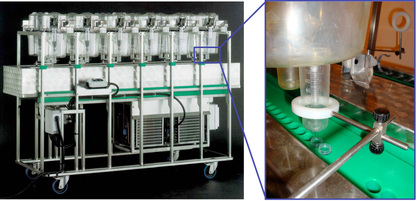Diuresis and renal function (metabolic cages)
Objectives
Urine harvesting using metabolic cages allows the repeated monitoring of diuresis and renal function in rats / mice. Moreover, the urinary excretion rate of a wide variety of substances can be biochemically determined in 24h-urine samples collected on a refrigerated rack (allowing urine collection from +4° down to -15° C) (figure 1), limiting thus the possible degradation of the excreted substance.
 |
| Figure 1: Overview of the refrigerated rack collector for 24-h urines collection. |
Summarized methodology
After a first stay with no urine collection to reduce the stress of the animal on the day of collection, the animals are placed in metabolic cages for a 24 h period to collect urine at a desired temperature from +4° down to -15° C. After recording the total urine volume, 24-h urine samples are centrifuged and supernatant stored for future biochemical determinations.
Endpoints
• 24-h urine volume
• refrigerated urine sample collection
Physiol Res (2009) : 58(4):499-509
Behr-Roussel, D. et al.
Am J Hypertens (2008) : 21(11):1258-1263
Behr-Roussel, D. et al.
Eur Urol (2008) : 53(6):1272-1281

Links to applicable Targeted disorders / Pathophysiological models





















 Download this page in PDF
Download this page in PDF